Cruising Atlantic Morocco
Instead of going along the main cruising route straight to the Canary Islands before their Atlantic crossing, this family of four chose to explore the Atlantic coast of Morocco first.
Published 7 years ago, updated 6 years ago
Experience Report September 2017 – SV MOYA
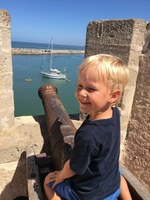

Instead of going along the main cruising route straight to the Canary Islands, we left the Algarve, Portugal, mid-September 2017 to cruise and explore the Atlantic coast of Morocco.
We, a family of 4 with two little boys (aged 2 and 4).
We started from Portimao with a 2 days/2 nights sail across the bay of Gibraltar and made landfall in Mohamedia in the absence of a functional Marina in Casablanca. On our way heading south along the Moroccan coast, we visited the fishing harbours of El Jadida and Essaouira by boat, as well as Casablanca and Marrakech by public transport, before crossing to Lanzarote.
Sailing conditions throughout the route have been good with a little swell from the NW, mostly light winds from the north and south-going current. Despite the complete lack of sailing infrastructure in the visited ports, we very much enjoyed the visit on the African continent, with its amazing cultural heritage, super friendly people and delicious dishes. We have always been welcomed warmly and did not encounter any issues with regard to safety, refugees or officials.
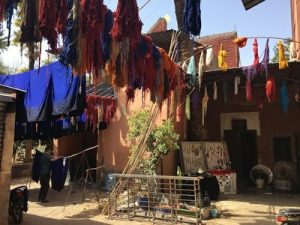

Immigration, Customs & Port Control
Before entering Moroccan waters, we hoisted the courtesy flag as well as the Q flag, the Q flag needed to been flown at each visiting port.
After arrival officials either visited Moya or we visited the immigration office, customs as well as port control. As clearance procedures were different in each individual port, refer to the individual ports section below for further details.
In all ports, full immigration was performed and clearance needed to be obtained prior to departure, thus our passports quickly filled up with Moroccan stamps!
Despite visiting 3 separate officials and not speaking French, inbound clearance worked in all ports effectively and took us 1-2 hrs (only the captain, the crew remained on board) with outbound clearance performed much faster.
Please note – Ship’s papers often are retained in the port and officials do not accept copies.
Our port of entry was Mohamedia, where Customs was supposed to issue a blue form detailing our customs declaration, to be carried on board until we leave the country. Prior to leaving Mohamedia we asked for the form, but were assured that we were ok to proceed without it, thus never received it. In subsequent ports, we were asked for the form, but officials accepted our explanations without any issues and cleared us to proceed.
Throughout, all officials have been very nice, relaxed and communicative, though many of them only spoke a little English.
In and Outbound Clearance was free of charge, in all ports, we only paid for berthing (25-35 Euros/night).
Baksheesh
We have not been asked to pay baksheesh by any official, nor did we have the impression that we were supposed to pay. In Mohamedia the immigration officer visited Moya for outbound clearance. We considered whether he might expect baksheesh and offered a tip, which he refused with the words “this is only my job”. Twice we have been asked for a bottle of wine by people who helped us with the lines, which we gladly offered.
Safety
We did not encounter any refugees, nor did we feel unsafe at any time. We always locked Moya and did not wear jewellery, but did not have any other safety prevention. People have been welcoming us truly warmly. For example, as we approached El Jadida at sunrise, I was sitting in the cockpit for lookout, as a waving fisherman in a very small boat came close to Moya, only to welcome us with a huge grin and recommended the best approach to the port.
SAILING
Winds & Swell
We visited Morocco from mid September to the beginning of October 2017.
During this time swell was always low to moderate from the north west. We had mostly light winds from the north which were sufficient for easy and pleasant sailing along the coast (twice with a light wind sail). The south-going current did help too.
During our stay in Essouira, winds according to our GRIB files did increase to 25-30 knots, but in the harbour, we experienced much less.
At the beginning of October we left for the Canary Islands, again the winds and swell have been light from the north.
Fishing Nets
Before heading into Morocco we read about abundant, unlit fishing nets along the coast, which might cause some hazards if one gets tangled. According to respective sources, fishing nets can be found even in water depths up to 100 meters, which can be more than 20 Miles off the coast. We specifically looked for these nets during daytime and also observed a few in close proximity to the ports of Mohamedia, El Jadida and Essouira. Also in our experience nets are unlit and also not easy to spot during the daytime, however nets were much fewer as expected (no more than along the Spanish and Portuguese Atlantic coast) and in our experience were only occurring in more shallow areas. During night time we travelled in water depths of more than 50 meters, mostly approximately 5 to 10 Miles off the coast, and did not have any issues.
Cruising Distance & Anchoring
There are only a few ports down the Atlantic coast of Morocco, thus traveling distances between the ports are significant.
As we came from Portimao from the Algarve, we did not visit Tangier or Rabat, but headed straight to Mohamedia. For our next port, we travelled 72 nm to reach the next harbour of El Jadida, in the absence of a functional Marina in Casablanca. We skipped Safi (approximately 90 miles from El Jadida) and headed straight to Essouira (137 miles from El Jadida). As travelling times would have meant very long day passages, we did all passages over night and approached the ports after sun rise, which worked perfectly fine for us. Anchoring in between the ports along the coast is only possible if a permit is received from the authorities, though opportunities along the un-sheltered coast are few in any case.


Provisioning
We bought fruits and vegetables at the fresh produce markets in the medinas of Mohamedia, El Jadida and Essaouira. In Mohamedia there is also a well-stocked Carrefour supermarket close to the mosque. In Essaouira, there is a big supermarket at the end of town, which a neighbouring yacht used to stock up prior to going to the Canaries. We felt that grocery prices in Morocco were generally a bit lower as compared to Europe, but not totally cheap.
Fuel
In Mohamedia there is in principle the possibility of getting some fuel. However as Moya has a significant draft of 1.9 meters, we could not access the fuelling pontoon at half tide. As we wanted to get 400 litres of fuel, we did not want to bother with jerry cans, which could have been organised by the marina. In El Jadida and Essaouira, there was no obvious fuelling station, but we did not ask if something could be arranged.
Water
It is possible to get water at the fuel pontoon in Mohamedia, but it is difficult to get water in El Jadida and Essaouira. We did not require to get water in Morocco, thus we can not comment on water quality in Mohamedia.
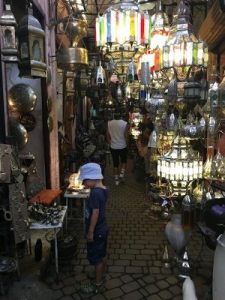

Mohamedia (Casablanca)
The marina in Casablanca should have been completed in 2015, but at the time of visiting we were not sure about the completion status, thus headed to Mohamedia instead. We visited Casablanca by train, which runs regularly several times a day and takes only 30 min to the old town of Casablanca. Casablanca is the major commercial centre of Morocco with a huge cultural heritage including the impressive Hassan II Mosque, thus we enjoyed the days here. We also visited the construction site of the new marina, which is very ambitious as they are actually building a whole new waterfront. According to estimates by locals, it will take at least 2 more years to complete.
Mohamedia is a port of entry which is well lit and we think is safe to approach also in heavy weather.
It has a small Marina embedded between the fishing harbour and very close to the commercial port. Actually, the tankers bringing oil to Morocco are only lying 50m from the Marina, thus it smells oily. The Marina is not comparable to European standards and is rather shabby and old, but the yachts are tied up safely and the staff is friendly despite not speaking any English. The showers are functional and clean.
Upon arrival, the marina staff (who did not respond to VHF) helped us with the lines and then called customs, port control and immigration.
The customs officer picked our captain up and together they filled out the forms on the marina terrace (but failed to file a blue form as mentioned above). Afterwards, Immigration visited Moya and we did the paperwork on board. The immigration officer retained ship papers, insurance confirmation and sailing license until departure. For the stamps in the passports and the shore pass, we needed to visit the immigration office prior to leaving the harbour area. Last port control came to our pontoon and collected berthing fees.
For outbound clearance, we received the ship papers at the immigration office and an officer joined us to check Moya for departure. Customs claimed we were clear to proceed as the immigration officer phoned.
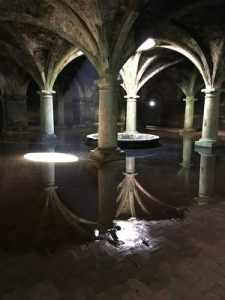

El Jadida is a small fishing harbour, which we approached from the north. On the southern side of the port there was standing surf, thus entry into the harbour at heavy weather might not be safe and one might want to head to the commercial port approximately 10nm to the south.
In the fishing port of El Jadida, there is a small pontoon on the southern side of the harbour below the Portuguese fortress, where it is possible to tie up for small vessels. The pontoon belongs to the local nautical club. Moya (39ft) was way too large for lying there, thus the only possibility to stay in El Jadida was to stay at anchor in the middle of the harbour. There is only space for few vessels to stay at anchor and the harbour master gives detailed guidance via VHF (channel 12) where exactly to anchor. The complete harbour is monitored by high-resolution cameras, thus instructions are very clear and anchor holding is very good in 3m above the mud.
The local club has showers, but we were not sure whether we were allowed to use them. Other than that there are no facilities.
For inbound clearance, we were picked up by the harbour master, who retained our ship papers and informed the immigration officer. Immigration picked our captain up by car. The immigration office is at the harbour exit to the city, where the paperwork was done. Next door customs needed to be declared.
On the day of departure, we needed to visit immigration, customs as well as port control for outbound clearance.
The town of El Jadida, besides its massive medina, has an old Portuguese village which belongs to the UNESCO world heritage. We have been especially impressed by the old cistern of the fortress.
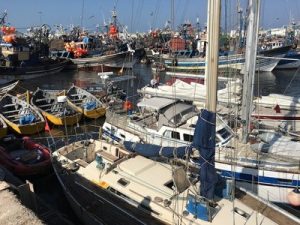

Essaouira is purely a fishing port with no yachting facilities at all. The port is not clean and very smelly.
There is a swimming pontoon on the east side of the harbour, where an old local yacht is permanently tied up. It was possible for us, together with two other visiting boats, to go alongside the yacht and secure Moya directly to land with one or two additional lines.
When we visited Essaouira there was a strong surge inside the fishing harbour and the boats were moving against each other. Also, the harbour was packed with fishing boats, that were hiding from increasing winds. The harbour master did recommend we leave the harbour, as fishing vessels sometimes can be rough in manoeuvering. Since we did not have any alternatives, we stayed in the harbour for 5 days without any trouble. For 2 days it would have not been possible to leave as the harbour, as it was jam-packed with small vessels.
We visited the medina of Essaouira and strolled through the narrow passages. Also, we left Moya for 2 days and one night and visited the amazing city of Marrakech, which is accessible by a 3 hr bus ride directly from Essaouira.
Inbound Clearance in Essaouira, the Immigration officer picked our captain up and guided him to the Immigration office. After doing the paperwork, Customs (located in the same building) had to be declared. The immigration officer then led us to the local police, who also required crew and ship data and sent us to the post office. In Essaouira port fees had to be paid in advance as the port is no longer allowed to retain ships papers.
For outbound clearance, all four offices had to be visited again. As we left early for the Canary Islands we received clearance the day before leaving the country.
Sabrina & Christian
SY Moya
The opinions expressed in this article are the author’s own and do not reflect the view of noonsite.com or the World Cruising Club
Related content
Related to following destinations: Atlantic Coast (Morocco), El Jadida, Essaouira, Mohammedia, Morocco

The itinerary described here is doing Morocco the hard way. The marinas in Rabat/Sale (Bouregreg Marina) and the one at Agadir are purpose-built for sailing yachts, though reports from Agadir indicate some swell and facility deficiencies. The Bouregreg Marina is nearly ideal, with excellent comfort and security, within walking distance of a rail connection to all major cities, and a tram connection to Rabat, bustling modern capital of Morocco. An overnight from Gib, Cadiz or Barbate, Bouregreg Marina is on the river of the same name, entered between stone breakwaters and over a shallow bar. Entry and exit should be in daylight, near high tide, with a swell of less than 2 meters. A VHF hail to the marina on approach will bring out a RIB to guide arrivals over the bar and up the river. The surfing website Magicseaweed.com is an excellent source of swell conditions and forecasts. Fuel is available in the marina, but my own experience with the fuel was not good, probably because this small marina doesn’t sell much diesel, and the big yachts generally bunker in their fuel. Filling jerry cans at a nearby gas station solves this problem. There is no haul-out or chandlery in this marina, but excellent cafes and restaurants. I wintered over there in 2011/2012 and found the winter weather much easier than any place in the Mediterranean. Rabat is at the southern end of the Gulf of Cadiz. Sheltered from the worst of Atlantic weather by the Iberian Peninsula and the African coast, stormy weather is relatively infrequent in this location. Essouira, further South and West is less protected, known for windy conditions and its chaotically crowded fishing harbor.